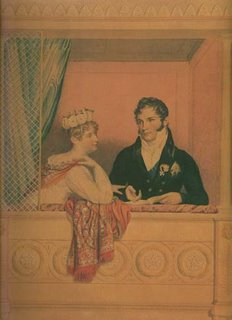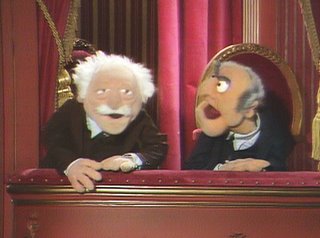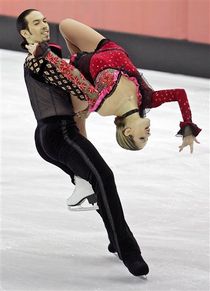 Taking a break from the pleasure of viewing athletic male bodies in tight bodysuits (isn’t men’s speed skating grand?) to do the final bit of myth-busting on the history of pregnancy and childbirth.
Taking a break from the pleasure of viewing athletic male bodies in tight bodysuits (isn’t men’s speed skating grand?) to do the final bit of myth-busting on the history of pregnancy and childbirth.
#4: Husbands were always excluded from the birthing chamber.
Well, yes and no. Much as my husband bemoaned the loss of the “good old days” and offered to take up smoking and pacing rather than attend me through my two labors, having the husband in the delivery room isn’t really a modern invention.
It’s true that the centuries-old childbirth traditions usually excluded males. There was a female bonding ritual associated with childbirth: closing up windows and doors, lighting candles, the drinking of caudle (a hot spiced wine or ale) by the laboring woman’s female friends and relatives. Usually the man was not welcome, but that was when births were attended by midwives.
When male practitioners were starting to get in on the act, it became inappropriate to exclude husbands. Believe it or not, some opponents of man-midwifery wrote, with great zeal, about the risks of the man-midwife becoming inflamed with passion by the sight of the laboring woman. I can just picture that, remembering what a femme fatale I must have looked during my two labors!
So husbands were not as a rule excluded from the birthing chamber. Old-fashioned female friends and relatives of the woman might complain or try to enforce the earlier ritual, but during the 18th century and into the 19th, the old rituals of childbirth were eroding, especially among the monied classes.
During Victorian times, when “chloroform-and-forceps” births became more common, the moral support provided by friends and family was increasingly replaced with medication. Doctors began to exclude any “unnecessary” persons from the birthing chamber, claiming they only distressed the patient anyway. By the time hospital births became more common (in the 1920’s and 30’s) everyone was excluded until the return to natural childbirth of our own time. And now there are some women who believe we should return to the old patterns of childbirth, with women helping women.
 Anyway, during “our period” husbands sometimes did attend their wives. Prince Leopold was quite devoted to Princess Charlotte and attended during her 50-hour fatal ordeal. So on a happier note, it is perfectly acceptable for a proper Regency hero to attend the heroine during the birth of their child. It is equally possible that a scummy husband would go off hunting.
Anyway, during “our period” husbands sometimes did attend their wives. Prince Leopold was quite devoted to Princess Charlotte and attended during her 50-hour fatal ordeal. So on a happier note, it is perfectly acceptable for a proper Regency hero to attend the heroine during the birth of their child. It is equally possible that a scummy husband would go off hunting.
So who do you think about men in the delivery room? If you lived in the Regency, what might you prefer? Would you like a return to the old ritual? How would you feel about having your mother, mother-in-law, sisters, cousins, girlfriends and neighbors all there egging you on? Would it feel supportive or overwhelming? Who would you not want to have there?
And oh yes, I was modern enough to want my husband there. He does a wicked neck massage that really helped. Bucking other trends, though, I refused to do that “hee-hee-hoo-hoo” breathing. And promised my husband that anyone bringing a camera or any recording device near me before the baby and I were cleaned up would die a quick but painful death. 🙂
Elena
LADY DEARING’S MASQUERADE, an RT Reviewers’ Choice Award nominee
www.elenagreene.com






